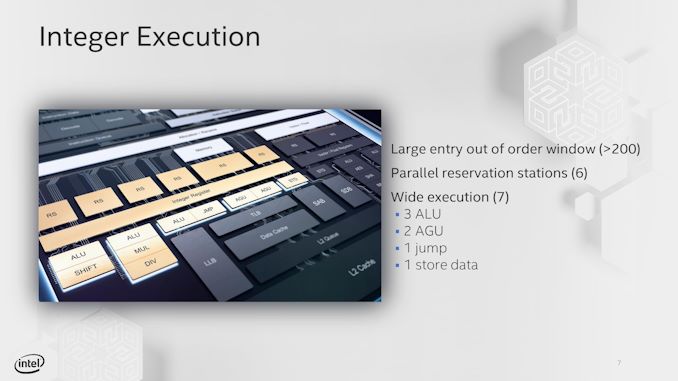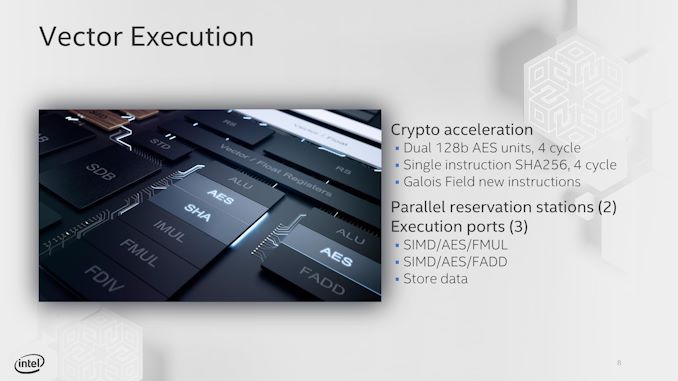Intel's new Atom Microarchitecture: The Tremont Core in Lakefield
by Dr. Ian Cutress on October 24, 2019 1:30 PM ESTA Wider Back End
Moving beyond the micro-op queue, Tremont has an 8 execution ports, filled from 7 reservation stations.
The only two ports using a combined reservation station are the address generator units (AGUs) - this is in stark contrast to the Core design, which in Sunny Cove uses a unified reservation for all integer and floating point calculations and three for the AGUs. The reason that Tremont uses a unified reservation station for the two AGUs, also backed by extra memory for queued micro-ops, is in order to supply both AGUs with either 2x 16-byte stores, 2x 16-byte loads, or one of each. Intel clearly expects the AGUs on Tremont to be fairly active compared to other execution ports.
On the integer side, aside from the two AGUs, Tremont has 3 ALUs, a jump port, and a store data port. Each ALU supports different functions, with one enabling shift functions and another for multiplication and division. Compared to core, these ALUs are extremely lightweight, and Intel hasn’t gone into specifics here.
On the floating point side, we are a little bit more varied – the three ports are split between two ALUs and a store port. The two ALUs have one focused on fused additions (FADD), while the other focuses on fused multiplication and division (FMUL). Both ALUs support 128-bit SIMD and 128-bit AES instructions with a 4-cycle latency, as well as single instruction SHA256 at 4-cycles. There is no 256-bit vector support here. In order to help with certain calculations, GFNI instruction support is included.
There is also a larger 1024-entry L2 TLB, supporting 1024x 4K entries, 32x 2M entries, or 8x 1G entries. This is an upgrade from the 512-entry L2 TLB in Goldmont.
New Instructions
As with any generation, Intel adds new supported instructions to either accelerate common calculations that would traditionally require lots of instructions or to add new functionality. Tremont is no different.
| TITLE | |||||
| AnandTech | Tremont | Goldmont Plus |
Goldmont | Airmont | Silvermont |
| Process | 10+ | 14 | 14 | 14 | 22 |
| Release Year | 2019 | 2017 | 2016 | 2015 | 2013 |
| New Instructions | CLWB GFNI ENCLV CLDEMOTE MOVDIR* TPAUSE UMONITOR UWAIT |
SGX1 UMIP PTWRITE RDPID |
RDSEED SMAP MPX XSAVEC XSAVES CLFLUSHOPT SHA |
SSE4.1 SSE4.2 MOVBE CRC32 POPCNT CLMUL AES RDRAND PREFETCHW |
|
(When asked what other new instructions are supported, Intel stated to look at the published documents about future instructions. When it was pointed out that those documents weren’t exactly clear and that in the past Intel hasn’t spoken about future designs, we were not afforded additional comments.)
When we get hold of a Tremont device, we’ll do a full instruction breakdown.












101 Comments
View All Comments
vladx - Friday, October 25, 2019 - link
Do you really expect Navi on future Atoms?GreenReaper - Saturday, October 26, 2019 - link
No. I was replying regarding '"the Ryzen embedded alternatives for home use".bananaforscale - Thursday, October 24, 2019 - link
Your Atom history is incorrect. The first ones were released Q2'08. Look up Silverthorne. (Yeah, I have one of the original ones.)xenol - Thursday, October 24, 2019 - link
I don't see where Ian said it started at Saltwell. Only that he mentioned the last few generations of Atom.digitalgriffin - Thursday, October 24, 2019 - link
Saltwell was the first true redesign of atom with ooe (out of order execution) iircIntelUser2000 - Friday, October 25, 2019 - link
No its not. Saltwell is a 32nm process shrink.Silvermont(Bay Trail platform) is the OoE execution Atom.
xenol - Tuesday, October 29, 2019 - link
The SoC implementation of Atom started with Saltwell. So if Ian's context was the SoC implementation, then starting at Saltwell makes sense.Namisecond - Friday, November 1, 2019 - link
If by 'SoC', you mean the tablet and phone chips, I think that was Silvermont, not Saltwell.maroon1 - Thursday, October 24, 2019 - link
Does this mean that all five cores can be used together by the application ??I think this will show 6 threads in task manager (cause sunny core has two threads, + 4 Atom cores)
skoo - Thursday, October 24, 2019 - link
Stay away from it (if it ever really comes out). I got left high and dry by intel with their previous atom foray into tablets. They decided it was a failure and just stopped supporting the chip (no more drivers for os upgrades) so I am stuck with a tablet with android 6.01 on it